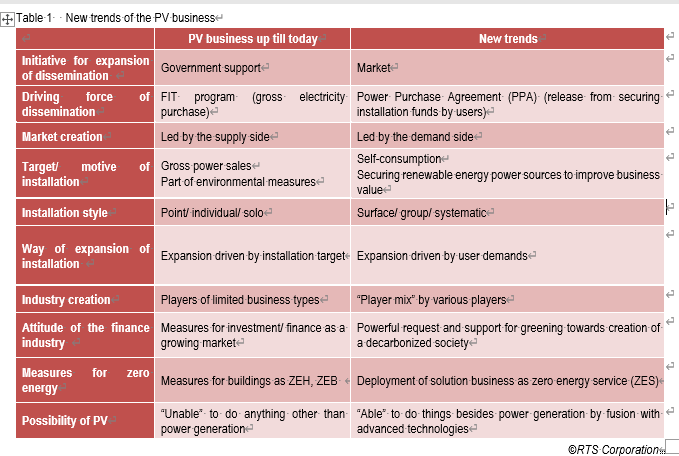Fiscal Year (FY) 2021 has started in April 2021. Nine years have passed since the enforcement of the FIT program in FY 2012, and FY 2021 is the last fiscal year for the current FIT act to be applied.
During this period, the PV purchase prices (FITs) greatly decreased from 42 Yen/ kWh (38.5 cents/kWh) to 11 Yen – 12 Yen/kWh (10.1 cents- 11 cents/kWh) for ≥ 10 kW PV systems and 48 Yen/ kWh (44 cents/kWh) to 19 Yen/ kWh (17.4 cents/kWh) for < 10 kW PV systems (residential).
The tender system for purchase prices started from FY 2017, and the subject of tender expanded from ≥ 2 MW projects to currently ≥ 250 kW projects.
The approved PV capacity as of the end of September 2020 was 74.4 GW, and the start of operation capacity (installed capacity) reached 53.3 GW.
The “Renewable Energy Promotion Act” under the “Acts for Establishing Resilient and Sustainable Electricity Supply Systems” will be put into force from FY 2022, and new rules will be launched such as coordination with the power market (FIP program) aiming towards creation of a renewable energy-oriented economic society.
Following the transition to these new programs, the business environment surrounding PV is expected to advance to a stage where specialty is required.
The PV industry has been preparing to deal with such changes. Furthermore, new trends are developing in business deployment surrounding PV with the 2050 Carbon Neutrality declaration in October 2020 by Prime Minister Yoshihide Suga.
The backgrounds of these developments include synergistic progression of transition of energy policy to make renewable energy a mainstream power source, induction of continuous cost reduction of PV taking into consideration the international price, and powerful approaches for renewable energy power utilization by the financial industry and power consumers.
Specifically, as shown in Figure 1, the PV industry will graduate from the stage of full dependence on government support with the energy policy and the environmental policy up till today, and shift to a new way of thinking and system based on the market, industry and consumer, looking from the perspectives of initiative for expansion of dissemination, driving force of dissemination, market creation, purpose and motive of installation, installation style, way of expansion of installation, industry creation, attitude of the finance industry, measures for zero energy, and the possibility of PV.
Currently, various ministries and agencies such as the Ministry of the Economy, Trade and Industry (METI), the Ministry of the Environment (MoE), the Ministry of Land, Infrastructure, Transport and Tourism (MLIT) and the Ministry of Agriculture, Forestry and Fisheries (MAFF) are progressing policy planning, legislation and deregulation towards creation of a decarbonized society at a speed higher than ever before. “The Sixth Strategic Energy Plan”, “Roadmap for local decarbonization” and the “MLIT Green Challenge” that greatly relates to dissemination of renewable energy are entering the final stage of discussion for formulation.
In April 2021, the three ministries of MLIT, METI and MoE newly established the Study Group on Energy Efficiency Measures, etc. in Housing and Buildings toward a Decarbonized Society, and opinion hearings were conducted on the obligation of PV module installation on newly-built houses.
As for the discussion towards formulation of the Sixth Strategic Energy Plan, the figures for the Continuous efforts scenario and the Enhanced policies scenario are already shown for installed capacity outlook for each of the five renewable energy power sources.
As for PV, the installed capacity is estimated to be 87.6 GW under the Continuous efforts scenario. However, under the Enhanced policies scenario, future measures by each of the ministries such as promotion of positive zoning in local regions by the revision of Law Concerning the Promotion of the Measures to Cope with Global Warming which is promoted by MoE, deregulation that enables PV installation on farmlands decided by MAFF, promotion of ZEH and ZEB progressed by MLIT, and grid utilization rules which are being revised by METI and support for PPA, etc. may enable an upward revision of PV installed capacity outlook, and the target figure is not yet set since further consideration is necessary at this stage.
Under such circumstances, Prime Minister Suga (via the Global Warming Prevention Headquarters) presented a new target to increase reduction of greenhouse gas (GHG) emissions to 46 % in 2030 compared to 26 % from the FY 2013 level, and participated in the Leaders Summit on Climate organized by the US government.
To achieve the new goal, Prime Minister Suga plans to prioritize renewable energy and strongly promote offshore wind power and PV power generation, especially for residential applications.
At present, the outlook of installed capacity under the Enhanced policies scenario was not set in the premise of achieving 46% reduction in GHG emissions by 2030. Therefore, it is necessary to revise the outlook once again.
The Enhanced policies scenario for power sources besides PV has been thoroughly considered, in addition, large volume additional installation is difficult, taking into account the lead time necessary for installation.
Given that, it is highly likely that the installed target for PV, which has not been presented yet under the Enhanced policies scenario, will be set to exceed 100 GW considering the short lead time for installation.
There are four fundamental issues that PV has to overcome: 1) economic efficiency; 2) variability as the power source; 3) restrictions of location and 4) grid restrictions. However, PV shall become the pillar to thoroughly support “46% reduction in GHG emissions by 2030” with the industry, government, academia and finance working together to accelerate overcoming the issues, and the PV industry making full efforts to greatly develop a new trend as mentioned above.
Since the “2050 Carbon Neutrality” declaration by Prime Minister Suga, the momentum for new installation of self-consumption type PV systems from the power consumer side is increasing, and it is an opportunity to progress expansion of PV dissemination with the PPA model which does not depend on the FIT program.

